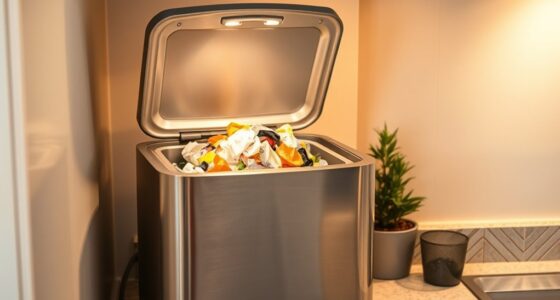Smart space heaters can provide efficient warmth if you follow safety guidelines, but they also pose fire risks if misused. To stay safe, choose models with proper safety features like tip-over switches and overheat protection, and make certain they are certified. Keep heaters stable, away from flammable materials, and never run them unattended. Smart controls help monitor safety and prevent hazards. Learn more about how to enjoy warmth safely and avoid common pitfalls.
Key Takeaways
- Modern space heaters with smart controls improve efficiency by scheduling and remote adjustments, reducing energy waste.
- Built-in safety features like tip-over and overheat protection minimize fire risks during operation.
- Proper placement and regular maintenance are essential to prevent hazards despite advanced safety mechanisms.
- Electrical safety measures, such as avoiding extension cords and using certified models, enhance overall safety.
- User awareness and monitoring, including smart alerts, help prevent accidents and ensure safe, efficient heating.
Understanding the Different Types of Space Heaters and Their Safety Features

Understanding the different types of space heaters and their safety features is essential to choosing a safe and effective heating option for your space. Oil-filled heaters, like the DeLonghi Dragon, emit heat similar to radiators and have fully contained mechanisms, which lowers fire risk. Ceramic heaters, such as the Lasko Bathroom Heater, heat quickly and include safety features that help prevent hazards. Many models come with safety certifications like UL or ETL, ensuring they meet safety standards. Features like automatic shutoff activate if the heater overheats or tips over, further reducing risks. Additionally, some space heaters have appliance leakage current interrupters (ALCI) on their plugs, preventing electrical shocks. Selecting a heater with proper safety features guarantees efficient warmth and peace of mind. Being aware of environmental considerations, such as minimizing impact on local ecosystems and following fire safety regulations, also contributes to safer and more responsible use. Incorporating fire safety awareness and regular maintenance can further enhance safe operation and prevent accidents.
Proper Placement and Setup to Prevent Fire Risks

To prevent fire risks, it’s crucial to place your space heater on a flat, stable surface that isn’t flammable, such as tile or concrete. Proper placement reduces the chance of fire hazards caused by tipping or contact with flammable materials. Keep your heater at least 3 feet away from curtains, bedding, and furniture to avoid igniting combustible items. Always position your space heater on a level, stable surface, never on uneven or unstable furniture or shelves. Use models equipped with tip-over switches and safety certifications like UL or ETL to enhance safety. Remember, avoiding placement near water sources and flammable materials minimizes electrical shocks and fire risks. Additionally, selecting a heater with safer design features can further prevent accidents and ensure safe operation. Regularly inspecting your heater for damaged cords or surfaces helps maintain safety and prevent potential hazards. Ensuring your space heater has proper safety certifications adds an extra layer of protection. Being aware of fire prevention practices is essential for maintaining a safe environment while using your heater. Following these safety tips ensures your space heater operates efficiently and safely.
Recognizing and Using Built-in Safety Mechanisms
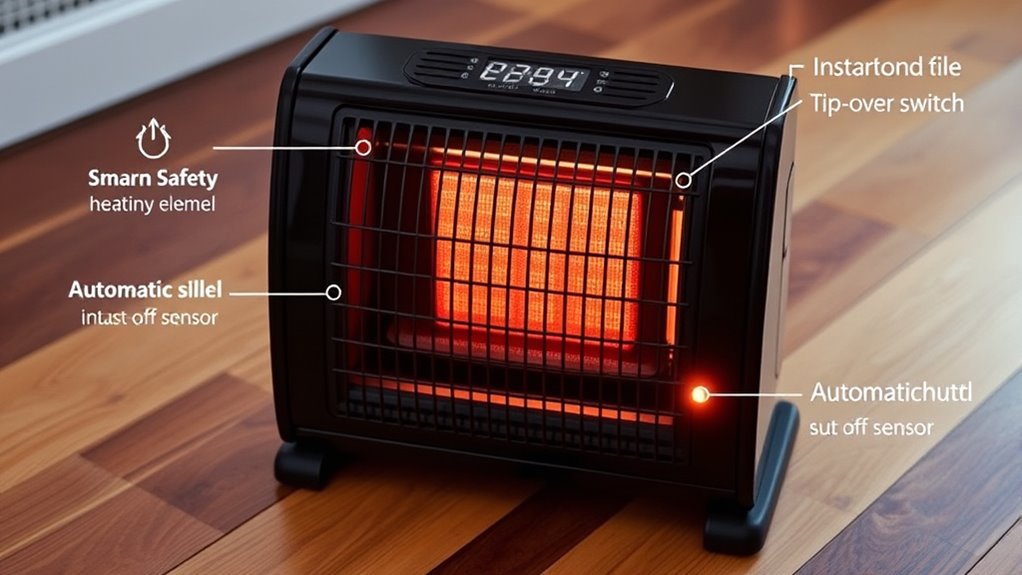
Many modern space heaters come equipped with built-in safety features designed to prevent fires and accidents. These safety mechanisms include tip-over switches that automatically shut off the heater if it’s knocked over, reducing fire risk. Overheat protection sensors detect rising temperatures and activate automatic shutoff to prevent overheating and damage. Heaters with UL certification have undergone rigorous testing to ensure these safety features work properly, enhancing heater safety. Indicator lights or alarms alert you when safety mechanisms are engaged or if maintenance is needed. Recognizing these features helps you operate your heater responsibly. Regularly inspect and maintain your heater to ensure safety mechanisms function correctly, keeping your space warm without compromising safety. Proper use of these built-in safety features is key to fire-safe heater operation. Being aware of safety standards can help you choose models that meet recognized safety criteria and reduce the risk of hazards. Familiarity with fire prevention measures can further ensure your heater operates safely and effectively. Additionally, understanding how automatic shutoff systems work can help you troubleshoot and maintain optimal heater performance.
Electrical Safety Tips for Safe Operation
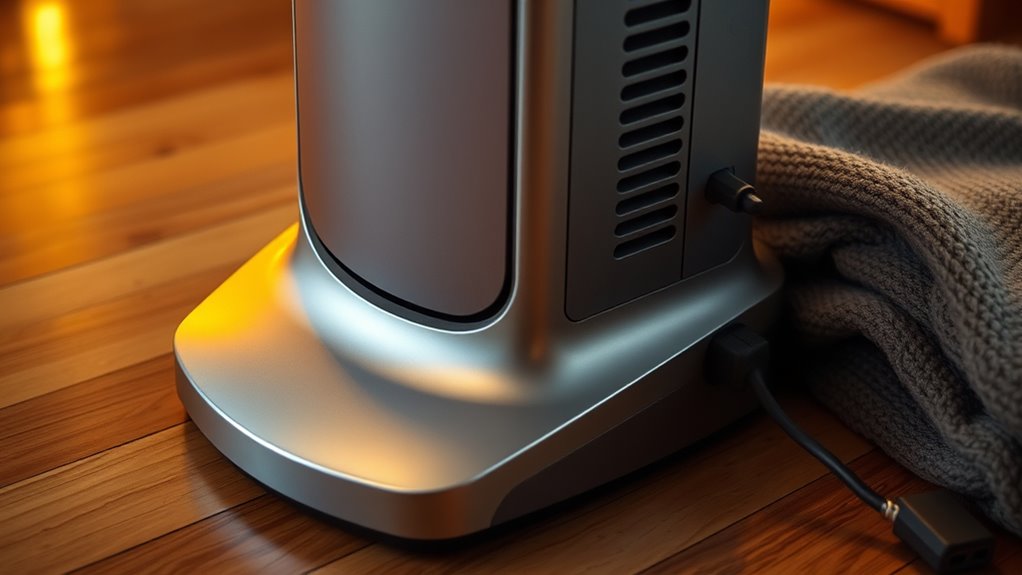
Always plug your space heater directly into a wall outlet to prevent overheating. Make sure the cord and outlet are in good condition and fit securely, avoiding extension cords or power strips. Using a dedicated circuit helps prevent overloads and reduces fire risks.
Proper Power Sources
Did you know that using the right power sources is essential for safe space heater operation? Always plug your heater directly into a wall outlet, avoiding extension cords or power strips, which can overheat and cause fires. Check that the cord and plug meet the heater’s wattage requirements and safety standards, ensuring they can handle the electrical load without risk. Keep several feet of clearance between the heater’s cord and heat sources or tight hinges to prevent heat damage or electrical faults. Regularly inspect cords and plugs for signs of damage, like fraying, melting, or brown heat marks—replace them immediately if you notice any issues. Unplug the heater when not in use or before cleaning to eliminate electrical hazards and reduce fire risks. Being aware of sound vibrations and their influence can also help in understanding potential safety features and health benefits associated with your heating choices. Additionally, understanding electrical safety standards can help you choose the safest equipment and prevent electrical fires. Always ensure your heater complies with established electrical codes for added safety and peace of mind. Moreover, selecting a heater with proper thermal protection features can further minimize risks during operation.
Cord and Outlet Safety
Using the correct cords and outlets is essential for safe space heater operation. Always plug the heater directly into a wall outlet and avoid extension cords or power strips, which can overheat and cause fires. Check your power cord and plug regularly for damage, fraying, or signs of wear—replace them if needed before use. Keep the cord untangled, not pinched, and away from heat sources or door hinges to prevent electrical shorts. Maintain at least a few feet of clearance between the cord and walls or furniture to reduce heat buildup. Make sure the outlet can handle the heater’s power requirements and avoid overloading it, which increases the risk of overheating and electrical hazards. Proper electrical safety helps prevent accidents and keeps your space heater safe. Additionally, understanding the importance of electrical safety practices can help you assess personal tendencies that might influence safe and responsible use of electrical appliances.
Smart Controls and Monitoring for Enhanced Safety

Smart controls let you adjust your space heater remotely and set schedules to turn it off automatically, reducing fire risks. Safety alert notifications keep you informed of abnormal temperatures or tip-over events through your app. These features give you peace of mind and better control over your heater’s safety. Additionally, monitoring signs of spoilage can help prevent potential hazards from malfunctioning appliances or unsafe conditions.
Remote Control Convenience
Remote control features in space heaters offer a convenient way to manage safety and comfort from anywhere. With remote control, you can quickly adjust temperature settings or turn off the heater if you notice overheating or if it’s left unattended. Many models come with smart controls that connect to your smartphone app, providing real-time alerts for safety issues like tip-over or overheat conditions. This allows you to respond promptly, reducing fire hazards caused by unattended operation. Additionally, scheduling functions help automatically turn off or modify the heater’s operation, minimizing risks. Data shows that heaters with remote control and monitoring features considerably decrease incidents related to fire and electrical hazards compared to traditional manual models, making your space safer and more convenient.
Safety Alert Notifications
Safety alert notifications elevate the convenience of remote controls by providing real-time updates on your heater’s status. With smart space heaters, you can receive alerts if overheating, tipping, or fire risks are detected, helping you prevent potential fire hazards. These notifications often trigger automatic shut off to stop dangerous conditions before they become serious. Remote monitoring lets you check your heater’s performance and safety status from anywhere, ensuring no unattended operation occurs. Many models meet certification standards like UL and ETL, giving you peace of mind. By detecting issues early, such as power surges or malfunctions, safety alert notifications profoundly reduce fire risks. Overall, they enhance safety without sacrificing the ease of use that smart controls offer.
How to Select a Safe and Efficient Space Heater

Choosing a safe and efficient space heater starts with selecting models that meet recognized safety standards like UL, ETL, or CSA certifications. These safety certifications guarantee the heater meets rigorous safety requirements, reducing fire hazards. Look for models with built-in safety features such as tip-over switches and thermal shutoff to prevent accidents if the heater tips over or overheats. To maximize energy efficiency, choose a heater appropriately sized for your room’s square footage, avoiding unnecessary energy waste. Smart controls and programmable timers can automatically turn off the heater when not needed, enhancing safety and saving energy. Always check reviews and safety ratings to find reliable, safe options. Proper selection helps you stay warm without compromising safety or efficiency.
Common Mistakes That Can Lead to Safety Hazards
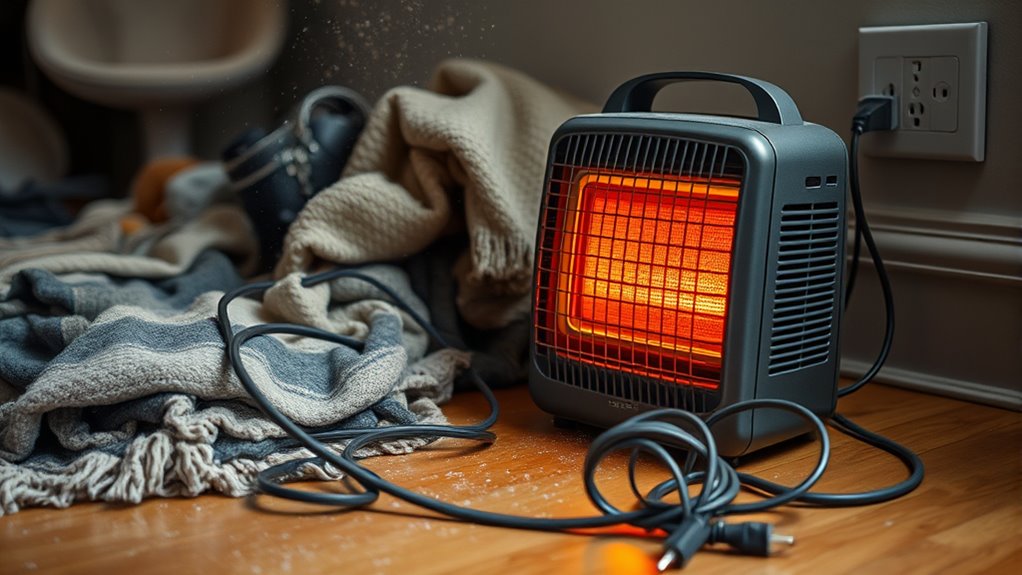
Even with the right safety features, improper use of space heaters can create serious hazards. One common mistake is placing your heater on unstable surfaces like furniture or rugs, increasing tipping hazards that can cause fires or injuries. Using extension cords or power strips is another risk, as they can overheat and lead to electrical fires; most space heaters require direct wall outlet connections. Leaving your heater unattended or running it overnight without safety certifications or automatic shutoffs dramatically raises fire risks. Additionally, operating heaters too close to flammable objects—like curtains, bedding, or paper—can spark fires if safety distances aren’t maintained. To guarantee space heater safety, always follow manufacturer instructions and avoid these common mistakes that can turn warmth into danger.
Maintaining and Inspecting Your Heater for Ongoing Safety
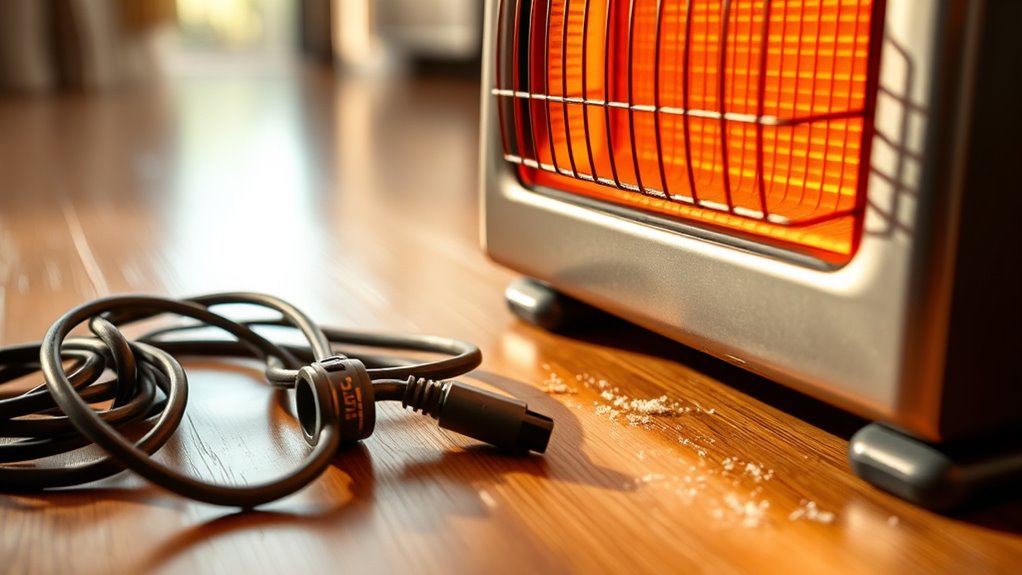
Regularly inspecting your space heater helps catch issues before they become hazards, so check the power cord and plug for damage. Keeping vents and filters clean guarantees safe, efficient operation and reduces fire risk. Don’t forget to test safety features monthly and follow proper storage guidelines when not in use.
Regular Inspection Checks
To keep your space heater operating safely, it’s essential to perform regular inspections for any signs of damage or malfunction. Check for damage like frayed cords, scorch marks, or melting plastic to prevent electrical hazards. Ensure safety features such as tip-over switches and thermal shutoff mechanisms are working correctly to avoid overheating risks. Routinely inspect vents and filters, cleaning dust and debris to maintain proper airflow and safe operation. Test smoke alarms and carbon monoxide detectors monthly to ensure they’ll alert you to any hazards caused by heater malfunctions. Follow the manufacturer’s maintenance guidelines and schedule professional inspections if you notice irregular operation or safety concerns. Regular inspection helps you catch potential hazards early, keeping your space warm and safe.
Proper Cleaning Practices
Keeping your space heater in peak condition requires more than just turning it on; proper cleaning is essential for safety and efficiency. Regularly inspect your heater’s vent and grills for dust and debris buildup, which can cause overheating or fire hazards. Follow the manufacturer’s instructions for cleaning, avoiding harsh chemicals or water that could damage internal parts. Use a soft brush or cloth to remove dust from vents and grills, ensuring unobstructed airflow. Before storing your heater during off-season periods, give it a thorough cleaning to prevent dust and debris from causing malfunctions later. Routine cleaning not only maintains ideal performance but also reduces fire risks by keeping all safety features like vents and grills clear. Proper cleaning practices are key to safe, efficient operation.
The Role of Certifications and Safety Ratings
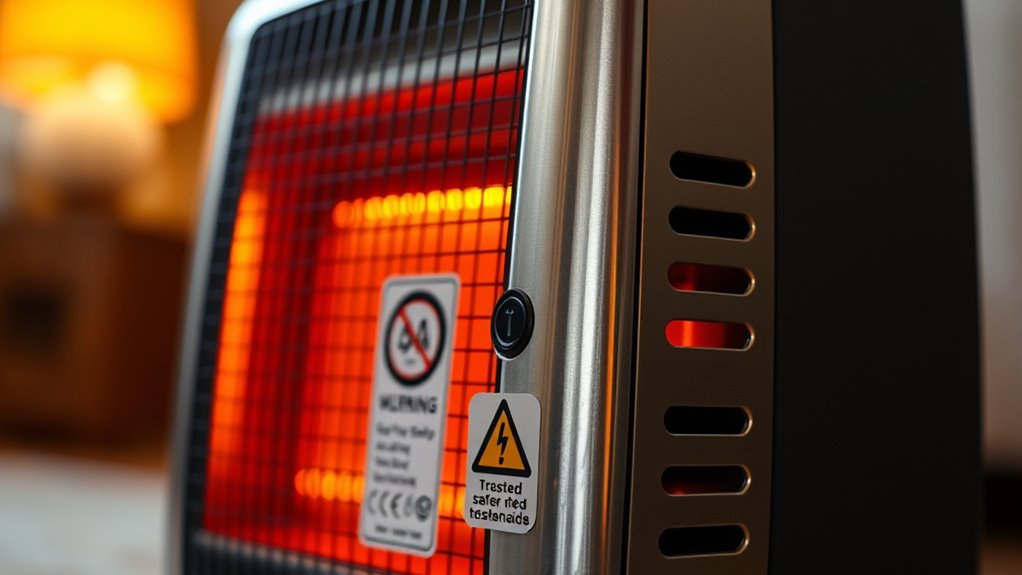
Certifications and safety ratings play a crucial role in guaranteeing your space heater operates safely and reliably. When you look for models with UL safety certification, you know they’ve undergone rigorous testing to meet strict safety standards. These certified heaters include essential safety features such as overheat protection, tip-over switches, and automatic shutoff mechanisms, reducing fire risks. The certification labels on the heater confirm compliance, giving you peace of mind. Heaters with recognized safety ratings are less likely to malfunction or cause accidents, especially if you plan to leave them unattended. Always verify the certification labels before purchasing. Doing so helps prevent electrical shock, fire hazards, and other safety issues, ensuring your warmth doesn’t come at a dangerous cost.
- Look for UL, ETL, or CSA safety certification labels
- Guarantee the heater has safety features like overheat protection and tip-over switch
- Check that it meets recognized safety standards
- Confirm certifications before use to prevent electrical shock
Tips for Safe Use During Sleep and When Unattended

When using space heaters, especially during sleep or when you’re away, safety features become even more important. Always choose heaters with safety shutoff, overheat protection, and automatic shutoff. Unattended operation requires unplugging the heater unless it has verified safety certifications. Maintain at least 3 feet of clearance from bedding, furniture, and curtains to prevent fires. Regularly inspect cords and safety features before leaving the room or sleeping to ensure proper functioning. Use heaters designed for overnight use with built-in safety features to reduce risks.
| Tip | Description |
|---|---|
| Safety shutoff | Automatically turns off if tipped over or overheating. |
| Unattended operation | Always unplug when not in use or during sleep. |
| Clearance | Keep at least 3 feet from combustibles. |
| Inspection | Check safety features and cords regularly. |
| Overheat protection | Prevents overheating, reducing fire risk. |
Frequently Asked Questions
How Likely Is a Space Heater Catching on Fire?
You’re probably wondering how likely a space heater is to catch on fire. The truth is, if you don’t follow safety guidelines, the risk increases markedly. Faulty cords, placement near flammable materials, or using extension cords can all cause fires. However, heaters with safety features like tip-over switches reduce this risk. Regular maintenance and proper placement are key, but accidents can still happen if safety rules aren’t followed.
Is It Cheaper to Turn up the Heat or Use a Space Heater?
Did you know space heaters use 1,000 to 1,500 watts? When deciding whether to turn up your central heat or use a space heater, consider your needs. If only one small room needs warmth, a space heater is more cost-effective and energy-efficient. Turning up the central heat heats the whole house but can spike your utility bills. Use space heaters safely for targeted, affordable warmth.
Is Leaving a Space Heater Plugged in a Fire Hazard?
Leaving a space heater plugged in can be a fire hazard if it’s damaged or faulty. Without automatic shutoff, it stays on even when you’re not around, increasing the risk of overheating and igniting nearby materials. Avoid using extension cords or power strips, and regularly check the cord and plug for damage. Unplugging the heater when not in use minimizes fire risks and keeps your home safer.
What Space Heater Is Not a Fire Hazard?
Choosing a space heater is like picking a trusted friend—you want safety first. Look for models with safety certifications like UL or ETL, which have passed strict tests. Opt for oil-filled heaters with enclosed elements, automatic tip-over switches, and cool-touch surfaces. These features act like a safety net, markedly reducing fire risks. When you select a heater with these qualities, you’re making a smart choice for safe, reliable warmth.
Conclusion
Remember, a space heater is only as safe as how you use it. Always stay vigilant—proper placement, regular maintenance, and understanding safety features can prevent accidents. Don’t let convenience turn into catastrophe; as the saying goes, “An ounce of prevention is worth a pound of cure.” When you treat your heater with care, you’ll enjoy cozy warmth without the risk. Stay safe, and keep safety first!



